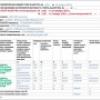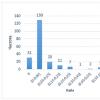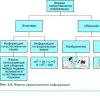Down syndrome. Causes, symptoms and signs, diagnosis of pathology, patient care. Family and children of people with Down syndrome Causes of children with Down syndrome
It is impossible to diagnose whether a child has a pathology with 100% certainty. However, Down syndrome does have symptoms during pregnancy.
Certain tests, when combined with each other and risk factors such as age and family history, can give an estimate of the likelihood that a child carries the trisomy 21 gene. Ultrasounds of fetuses with Down syndrome are performed, and diagnostic tests are offered that determine whether the child carries gene, but they have a risk of miscarriage.
Under normal circumstances, a human cell contains 23 pairs of chromosomes, with each pair consisting of one chromosome from each parent. Down syndrome, also known as , occurs when a baby has an extra copy of chromosome 21 in some or all of its cells
Why it appears, the causes of Down syndrome (an additional complete or partial chromosome) in the fetus are still unknown. Age-related risk of trisomy 21 is the only proven factor. 80% of children with Down syndrome are born to women after 30 years of age.
Anyone can have a baby with a chromosomal abnormality
Contrary to popular belief, the child does not inherit Down syndrome.
The only type that can be passed from parent to child is the VNI translocation. However, it is a rare form that is diagnosed in early pregnancy.
Inheriting a translocation means that the father or mother has rearranged genetic material. This means that the person is a balanced carrier, one who has no signs or symptoms but can easily pass it on to a child.
Risks of trisomy
Talk to your doctor to find out if you are at risk for Down syndrome during pregnancy.
The expected risk of trisomy 21 is the underlying cause of Down syndrome in almost 95% of cases. In this case, the child receives three copies of chromosome 21 in all cells instead of two, one from each parent.
It occurs as a result of abnormal cell division while sperm or eggs are developing. People with this type have (47 instead of 46) in each cell.
Risk factors may vary depending on the type of abnormality.
Trisomy 21 basic risk:
- The risk of having a child with a genetic problem increases as a woman gets older.
- There is a previous pregnancy in which the fetus had Down syndrome. Women who have had a pregnancy with trisomy 21 have a 1-in-100 chance of having another similar child.
Mosaicism. This type is caused only by certain cells producing 47 chromosomes. Mosaicism occurs in 3 out of 100 people with Down syndrome. Risk factors for mosaicism are similar to those for trisomy 21.
Trisomy 21 individual risk occurs with translocation - the only one that can be transmitted through families. A person with this type has 46 chromosomes, but part of one chromosome breaks and then attaches to another chromosome.
You may be a carrier of a translocation chromosome if you have:
- Family history of Down syndrome.
- Have had other children with this pathology.
Is it possible to detect Down syndrome using an ultrasound?
There is a small chance that a specialist will detect Down syndrome on an ultrasound. These include an increase in skin volume in the back of the head, a decrease in the size of the hip, or cysts in the brain. According to doctors, Down syndrome cannot be diagnosed by ultrasound. This test will not detect the expected risk of trisomy 21.
Ultrasound imaging at 20 weeks can be used to screen for Down syndrome in the fetus.

1 Ultrasound of a fetus with a large bladder 2 Enlarged NT and missing nasal bone in an 11-week fetus with Down syndrome
Echo signs of Down syndrome on ultrasound, which indicate an increased risk when observed in the second trimester of pregnancy.
A fetus with Down syndrome may have a small or absent nasal bone, large cerebral ventricles, a thick nuchal fold, and an abnormal right subclavian artery.
The presence or absence of many signs is more accurate.
Each person has hereditary (genetic) information, according to which all processes of development and functioning of our body are realized, packaged in the form of genes. There are a huge number of genes. These, in turn, are grouped into special structures called chromosomes. Normally, a person has 46 chromosomes in each cell of his body (with the exception of germ cells: eggs and sperm). These 46 chromosomes are combined into 23 pairs. In germ cells there is only half of the entire set of chromosomes, one from each pair, i.e. 23.
Chromosomes within one pair are similar to each other in shape, size and structure, but differ in the same characteristics from other pairs. Imagine 23 pairs of multi-colored boxes (the first pair is two green long boxes, the second pair is two red square boxes, the third pair is two blue oval boxes, etc.), which are filled to the brim with various small things. So, each box is a chromosome, and the little things in it are genes. This is how genetic information is stored in our cells.
People with Down syndrome have excess genetic material. As a rule, instead of 46, they have 47 chromosomes in each cell, i.e. one more chromosome. And if each pair contains 2 chromosomes, then people with Down Syndrome have three chromosomes in the 21st pair instead of two. In medicine this condition is also called “trisomy (from the word “three”) of the 21st chromosome.” This is the most common variant of Down Syndrome - 95% of all cases. 5% of people with Down syndrome may have other genetic forms of this pathology.
Thus, Down Syndrome is a genetic condition that is caused by the presence of excess genetic material, most often an extra (third) chromosome 21.
Incidence of Down Syndrome.
The average birth rate of children with Down Syndrome is 1 case per 1000 births.
It should be noted that, despite this seemingly low frequency, Down Syndrome is the most common genetic pathology among people. This is why medicine pays so much attention to the possibility of identifying Down Syndrome in an unborn child.
What determines the likelihood of having a child with Down Syndrome?
The age of the mother at the time of birth is the main factor on which the likelihood of having a child with Down Syndrome depends. The older the woman, the higher the risk of having a child with Down Syndrome. This is explained by the fact that the older a woman is, the more often her pathological egg can mature.
Normally, the egg (Egg) in women and sperm (Sp) in men contain only 23 chromosomes, i.e. exactly half of the total number of chromosomes, one from each pair. This is the unique difference between germ cells and all other cells in the body. During fertilization, i.e. When the fusion of an egg and a sperm occurs, a one-cell embryo with 46 chromosomes is formed.
Yts (23 Chr) + Sp (23 Chr) = Single-celled embryo (46 Chr).
As a woman ages, the chances of maturing a pathological egg, which contains not 23, but 24 chromosomes (instead of one 21st chromosome, two), increase. Upon fertilization and fusion with the chromosomes of the sperm, the embryo receives 24 chromosomes from the mother (including two 21st chromosomes) and 23 chromosomes from the father. In total, as a result, 47 chromosomes are obtained, of which three are 21st. This is the most common genetic mechanism for the formation of Down Syndrome.
Yts (24 Chr) + Sp (23 Chr) = Single-celled embryo (47 Chr).
Two 21's XP + One 21st Chr = Three 21st Chr
Even an 18-year-old woman can mature a pathological egg and give birth to a child with Down Syndrome, but the likelihood of this is much less at 18 years old than, for example, at 40 years old. The risk of having a baby with Down Syndrome increases sharply after 35 years of age. In the table below you can see the average probability of having a child with Down Syndrome among women of your age.
|
Mother's age at birth |
Risk of Down syndrome |
|
15 or less |
1:720 |
|
1:800 |
|
|
1:900 |
|
|
1:1030 |
|
|
1:1200 |
|
|
1:1200 |
|
|
1:1200 |
|
|
1:1030 |
|
|
1:1030 |
|
|
1:900 |
|
|
1:900 |
|
|
1:850 |
|
|
1:800 |
|
|
1:760 |
|
|
1:720 |
|
|
1:690 |
|
|
1:650 |
|
|
1:550 |
|
|
1:440 |
|
|
1:360 |
|
|
1:280 |
|
|
1:210 |
|
|
1:160 |
|
|
1:130 |
|
|
1:100 |
|
|
1:75 |
|
|
1:60 |
|
|
1:45 |
|
|
1:35 |
|
|
1:30 |
|
|
1: 21 |
|
|
1:17 |
|
|
1:13 |
|
As you can see, the younger the mother is at the time of birth, the lower the risk. However, if we take all the children with Down Syndrome, then 70-80% of them were born to women under 35 years of age. This happens because the total number of pregnancies and births under 35 years of age is several times higher than for those older than this age.
Consulting obstetrician, Ph.D. Borisova Alexandra Viktorovna.
Can a child with Down syndrome be born to relatively healthy parents who, according to all the rules, planned the pregnancy in advance? Doctors say that this is purely a genetic accident. The reasons for the birth of children with Down syndrome could only be identified from the statistics of such cases in medical practice, the theoretical analysis of genetic scientists and the history of genetic examinations of “sunny” children. Why are children born with Down syndrome? When can an anomaly be detected? Are there ways to prevent the syndrome?
Why are children born with Down syndrome?
From a physiological point of view, pathology appears during cell division after conception. The egg begins to actively divide, not yet moving through the fallopian tubes. By the time it attaches to the uterine cavity (the so-called implantation), it already becomes an embryo. If a child has Down syndrome, it will be clear almost immediately after conception, but it is still impossible to diagnose a genetic pathology so early.
“Sunny” children appear because one extra chromosome appears in the genetic material of the mother or father. In most cases (90%), the embryo receives chromosome 24 from the mother, but it happens (10%) from the father. In some cases (almost 6%), the pathology is associated with the presence not of a whole extra chromosome, but only of its fragments.
This is exactly how doctors answer the question of why children are born with Down syndrome. The causes and factors that provoke genetic pathology can be different, and the process is described above only from a physiological point of view.
What can “sun” disease be?
There are several forms of Down syndrome. Trisomy is the most common case. Trisomy is a pathology in which one of the parents' germ cells contains an extra 24th chromosome (normally, a child receives 23 chromosomes from the father and the same from the mother). Merging into a second cell, the egg or sperm forms a gamete with 47 chromosomes together with 46.
There is a so-called “family” syndrome. In this case, the birth of a “special” child is due to the fact that in the karyotype of one of the parents there is a so-called Robertsonian translocation. This is what doctors call the long arm of chromosome 21, which in the process of joining and dividing cells becomes the cause of trisomy.
The mildest form of “solar” disease is mosaicism. Genetic pathology develops in the embryonic period due to nondisjunction of chromosomes during cell division. In this case, the disorder occurs only in individual organs or tissues, while with trisomy, the anomaly is carried by all cells of the little person’s body.

How does maternal age affect the risk of having a child with Down syndrome?
Why are children born with Down syndrome? Doctors have several opinions on this matter. The most common reason is the age of the expectant mother. The older the mother, the greater the risk of having a baby with any anomalies. At the age of twenty-five, the probability of conceiving a defective baby is less than one tenth of a percent, and by the age of 40 it reaches five percent. According to medical statistics, 49-year-old mothers give birth to one child with Down syndrome in twelve cases.
In reality, the majority (almost 80%) of “sunny” children are born to young mothers under the age of 30. This is because older women tend to give birth less often. So, the reasons for the appearance of children with Down syndrome in these cases are different.
What about the father's age?
For men, the risk of conceiving a special child increases only after 42-45 years. As a rule, this is associated with an age-related decrease in sperm quality. The likelihood of conceiving a “sunny” baby is also influenced by genetic abnormalities in the cells of both the father and mother. Some of them are not a congenital phenomenon, but an age-related change. Sometimes there are cases when there are forty-five chromosomes in the cells of spouses - then the risk of pathology increases.
What genetic causes are risk factors?
The risk of having a child with Down syndrome is higher if the parents' cells contain similar genetic information. Often, “sunny” children are born from closely related relationships, but occasionally it happens that similar material is contained in the cells of parents who are in no way related by blood.

The birth of a child with Down syndrome is also possible if there are genetic diseases, unfavorable heredity and predisposition in the pedigree. There is a risk if the mother has diabetes, epilepsy, or has an unfavorable medical history: there have been miscarriages in previous pregnancies, stillbirths, or the death of a child in infancy.
Does lifestyle affect the risk of having a “sunny” child?
Why can a child be born with Down syndrome? Doctors say that the lifestyle of future parents does not affect this in any way. However, another indication of a more attentive attitude towards the expectant mother at the first screening will be the fact of long-term work in hazardous production. Unfortunately, it is rarely possible to find out exactly what caused the conception of a “sunny” baby, so it will not be possible to provide statistics here.
In addition, in some cases, children with Down syndrome (we study the causes of pathology throughout the entire article) are born due to abnormalities in the development of pregnancy. True, this can most likely be attributed to genetic reasons.
What is folate cycle disorder?
Most likely, it is a violation of the folate cycle that causes the birth of children with Down syndrome in young and relatively healthy mothers. What is meant by this phrase, why are children born with Down syndrome? The reasons may be disturbances in the absorption of folic acid (also known as vitamin B9).
Doctors always prescribe folic acid for both those who are already pregnant and those who are just planning a pregnancy. B9 is not prescribed in vain - a deficiency of the element can cause not only Down syndrome, in which chromosomes do not separate, but also other pathologies of embryonic development.

Why is vitamin B9 not absorbed? Three genes are responsible for this, which are also called folate cycle genes. Sometimes they “do not work at full capacity” and instead of 100%, the body absorbs at best 30% of folic acid. Women who do not fully absorb the vitamin should take folic acid in increased dosages and eat foods enriched with B9 more often. You can find out if there are folate cycle disorders by doing a genetic test.
A lack of vitamin B9 can cause digestive problems that interfere with the absorption of nutrients.
Have you done any more research?
The above are the reasons why children with Down syndrome are born. But medicine does not stand still. Recent research allows us to identify two more factors that could theoretically influence the likelihood of having “sunny” children.
Indian scientists have found that not only the age of the mother herself, but also the age of the maternal grandmother can become a risk factor. The older the grandmother was when she gave birth to her daughter, the higher the likelihood that she would give birth to a grandson or granddaughter with Down syndrome. The risk increases by 30% with each “lost” year after the age of 30-35.
Another assumption made by scientists after recent research into the issue suggests that the occurrence of pathology may be influenced by increased solar activity. Thus, according to the observations of medical scientists and geneticists, the conception of such children often occurred after a surge in solar activity.
What do psychologists and esotericists say about the reasons for the birth of “sunny” children?
Why are children born with Down syndrome? Parapsychologists answer this question by referring to karmic debts. They say that in every family there must appear the person who is destined. And if the parents were really expecting a boy, and a girl appears, then it is likely that she will subsequently have a baby with Down syndrome. If, as an adult, a woman decides to have an abortion when it turns out that there is a genetic anomaly, then the unhealthy karma will be passed on to other children who will be born in this family.

By the way, according to an ancient legend, which is confirmed by modern esotericists, “solar” children are the reborn souls of sages and healers, who in a past life were distinguished by pride. For this they were placed in a shell that makes other people wary, but in return they were endowed with a deep understanding of the world.
How is a genetic disease diagnosed?
Today, early diagnosis of pathology is available. In the early stages of pregnancy, ultrasound diagnostics and biochemical screening are used. The material for research is the membrane of the embryo or amniotic fluid. The latter method is quite risky; there is a possibility of damage to the placenta (with all the negative consequences) or spontaneous termination of pregnancy. That is why amniotic fluid analysis and biopsy are carried out exclusively when indicated.
After birth, diagnosing pathology is not difficult. How are children with Down syndrome born? Such babies weigh less than usual, their eye shape is Mongoloid, the bridge of their nose is too flat, and their mouth is almost always slightly open. Often “sunny” children have a number of concomitant diseases, but these are not always mental disorders.
What do parents do when they find out that their child has a genetic disease?
Down syndrome can be diagnosed in the early stages of pregnancy, when termination is possible with virtually no harm to the health of the expectant mother. This is exactly what women in Russia most often do. Still, raising a “sunny” child requires a lot of effort, peace of mind, time and money. Such babies need much more parental attention and care, so women who are diagnosed with a genetic abnormality of the fetus cannot be condemned.

More than 90% of women terminated their pregnancies when it was discovered that the fetus had Down syndrome. About 84% of newborns with this genetic disease are abandoned by their parents in maternity hospitals. In most cases, medical personnel only support this.
What about other countries?
European mothers had an abortion in 93% of cases if doctors diagnosed a genetic pathology (data from 2002). The majority of families (85%) in which a “sunny” baby appears, abandon the child. What is significant is that in Scandinavian countries there is not a single case of abandonment of such children, and in the United States more than two hundred and fifty married couples are in line to adopt them.
Who leaves behind a special child?
Of course, some families keep the child. There are known children of celebrities with Down syndrome. The special baby is being raised by Evelina Bledans, coach of the Spanish football team Vicente del Bosque, Lolita Milyavskaya (at first doctors diagnosed Down syndrome, but then changed the diagnosis to autism), daughter of the first Russian president Tatyana Yumasheva.
“Sunny” babies develop more slowly than their peers. They are shorter, retarded in physical development, often have poor vision and hearing, are overweight, and often have congenital heart defects. There is an opinion that children with pathology are not capable of learning, but this is not true. If you regularly work with such a baby and pay attention to him, then he will be able to take care of himself and even perform more complex actions.
How are children with the syndrome treated and adapted to society?
It is impossible to completely cure a genetic anomaly, but regular medical observation and systematic classes in special programs will help a “sunny” baby acquire basic self-care skills and even subsequently get a profession, and then start his own family.

Classes with disabled children can be carried out both at home and in special rehabilitation centers, in kindergartens and schools. It is necessary to instill in the child self-service skills, teach writing and counting, develop memory and perception, and adapt socially. Speech therapy massage, breathing exercises, exercises for the development of motor skills, educational games, physiotherapy, and animal-assisted therapy are useful for “sunny” children. It is also necessary to treat concomitant pathologies.
Are there methods to prevent Down syndrome?
To prevent the risk of developing Down's disease, it is necessary to undergo examination by medical specialists even when planning pregnancy. It is advisable to do a genetic test to determine whether there are disturbances in the absorption of folic acid; visit a gastroenterologist if there is a suspicion of insufficient absorption of vitamins and nutrients.
It is worth starting to take vitamin B9 and multivitamins for pregnant women in advance. It is advisable to diversify your diet, saturating it with all the necessary nutrients. During late pregnancy, you need to undergo regular medical examinations and be more attentive to your new condition.
Down syndrome was first described by the famous British physician John Langdon Down, who began his research work in 1882 and publicly published its results in 1886.
This is one of those pathologies that every person has an idea about. This disease is especially worrying for expectant mothers who are warily awaiting their first screening. According to recent decades, this pathology occurs in every 700 babies born.
Statistics from the last few years show a different figure - 1 child born with a pathology per 1,100 newborns, which became possible thanks to highly accurate prenatal diagnosis and early termination of such pregnancies.
About 80% of children with this pathology are born to women under 35 years of age - despite the relatively low risk of the fetus developing this chromosomal pathology, a peak birth rate is observed in this age group. Every year, about 5,000 newborn babies with Down syndrome are added worldwide.
Down syndrome affects both girls and boys equally; the disease has no ethnic distribution and is found everywhere.
In 2006, International Down Syndrome Day was introduced on March 21. This day is held in order to increase public awareness of this common pathology and improve the quality of life of sick people. The number 21 was chosen due to the cause of the disease - trisomy 21, and the month of March represents trisomy, since it is the third month of the year.
Causes of Down syndrome development
The causes of Down syndrome lie in the intrauterine formation of a chromosomal pathology of the fetus, characterized by the formation of additional copies of the genetically embedded material of the 21st chromosome, either the entire chromosome (trisomy), or sections of the chromosome (for example, due to translocation). The normal karyotype of a healthy person consists of 46 chromosomes, and in Down syndrome the karyotype is formed by 47 chromosomes.
The causes of Down syndrome are in no way related to environmental conditions, parental behavior, taking any medications or other negative phenomena. These are random chromosomal events that, unfortunately, cannot be prevented or changed in the future.
Risk factors for developing Down syndrome
The age of the expectant mother affects the risk of developing Down syndrome in the child:
- in the age range from 20 to 24 years, the probability of developing this pathology is 1 in 1562;
- at the age of 25-35 years, this risk is already 1 in 1000;
- at the age of 35-39 years the risk increases to 1 in 214;
- Over the age of 45, the risk increases to 1 in 19.
As for the age of the future father, the risk of having children with this syndrome in men over 42 years of age has been scientifically proven.
There is a computer program “PRISCA”, which takes into account ultrasound data, physical gynecological examinations and other factors and calculates the risk of congenital pathology of the fetus. To calculate the risk of Down syndrome and the risk of developing defects of the central nervous system (neural tube defect), the following is taken into account:
- Mother's age
- Smoking
- Gestational age
- Ethnicity
- Body weight
- Number of fruits
- Diabetes disease
- Availability of IVF
Is it possible to inherit Down syndrome?
Trisomy on chromosome 21 (which is approximately 90% of cases of the disease) is not inherited and is not transmitted hereditarily; the same applies to the mosaic form of pathology. The translocation form of the disease can be hereditary if one of the parents had a balanced chromosomal rearrangement (this means that part of a chromosome changes places with part of some other chromosome, without leading to pathological processes). When such a chromosome is passed on to the next generation, an excess of genes on chromosome 21 occurs, leading to the disease.
It is worth noting that children born to mothers suffering from Down syndrome are born with the same syndrome in 30-50% of cases.
How to find out about Down syndrome during pregnancy?
Since the causes of Down syndrome in the fetus are genetically determined, this pathology of the child can be recognized in the womb. If Down syndrome is suspected, signs during pregnancy are detected already in the first trimester.
Diagnosis of Down syndrome determines the risk of developing this pathology in the fetus. The study is carried out strictly during the period from 11 to 13 weeks and 6 days of pregnancy.
- Determination of the level of the β-subunit of human chorionic gonadotropin (pregnancy hormone hCG) in the venous blood of the mother. With this chromosomal pathology of the fetus, an increased level of the β-subunit of hCG will be determined, more than 2 MoM;
- Determination of the level of PAPP-A - protein-A in the blood plasma of a pregnant woman, associated with pregnancy. A high risk of the syndrome is associated with a PAPP-A value of less than 0.5 MoM;
- Determination of the thickness of the nuchal translucency using fetal ultrasound. In Down syndrome, this figure exceeds 3 mm.
When the three described indicators are combined, the probability of Dyne syndrome in the fetus is 86%, i.e. diagnosis is quite accurate and indicative. To make a decision about continuing the pregnancy or terminating it, a woman who has signs of Down syndrome in the fetus is offered a transcervical amnioscopy.
In this study, chorionic villi are collected through the cervix, which are sent for genetic research, the results of which can confirm or refute this diagnosis with 100% certainty. The study is not mandatory; the decision to conduct it is made by parents. Since it is associated with a certain risk for the further course of pregnancy, many refuse such a diagnosis.
Diagnosis of Down syndrome in the second trimester is also a combined screening, which is carried out between 16 and 18 weeks.
- Determination of the level of hCG in the blood of a pregnant woman - with Down syndrome, the indicator is above 2 MoM;
- Determination of the level of a-fetoprotein in the blood of a pregnant woman (AFP) - for Down syndrome, the indicator is less than 0.5 MoM;
- Determination of free estriol in the blood - a value of less than 0.5 MoM is characteristic of Down syndrome;
- Determination of inhibin A in a woman’s blood - an indicator of more than 2 MoM is characteristic of Down syndrome;
- Ultrasound of the fetus. If Down syndrome is present, ultrasound signs will be as follows:
- smaller fetal size relative to the norm for a period of 16-18 weeks;
- shortening or absence of the nasal bone in the fetus;
- reduction in the size of the upper jaw;
- shortening of the fetal humerus and femur;
- increased bladder size;
- one artery in the umbilical cord instead of two;
- oligohydramnios or absence of amniotic fluid;
- increased heart rate in the fetus.
If all the signs are combined, the woman is offered invasive diagnostics to conduct a genetic study:
- transabdominal aspiration of placental villi;
- transabdominal cordocentesis with puncture of the umbilical cord vessels.
The selected material is examined in a genetic laboratory and makes it possible to accurately determine the presence or absence of this pathology in the fetus.
In 2012, British scientists developed a new highly accurate test for the presence of Down syndrome in the fetus, the result of which is estimated at 99%. It involves testing the blood of pregnant women and is suitable for absolutely all women. However, it has not yet been introduced into world practice.
How is the issue of termination of pregnancy decided when a high risk of Down syndrome is determined in the fetus?
When children are born with Down syndrome, the causes of the genetic failure that have occurred are truly impossible to establish. Many parents perceive this as a test and consider themselves endowed with a special function in raising and developing such a child. But every pregnant woman with a high risk of this pathology faces the question of deciding the fate of her pregnancy. The doctor does not have the right to insist on interruption, but he is obliged to clarify this issue and warn about all the likely consequences. Even if pathologies incompatible with life are discovered, no one has the right to persuade a woman to decide to do it), much less force her to do it.
Thus, the fate of a pregnancy with fetal pathology is decided only by the parents. Parents have the right to repeat the diagnosis in another laboratory and clinic, consult with several geneticists and other specialists.
Signs of Down syndrome in a newborn
Signs of Down syndrome in newborns are determined immediately after birth:
When children with Down syndrome are born, almost all of the external signs listed above will be detected. The diagnosis is confirmed after a genetic karyotype test.
Can a child with Down syndrome grow up to be a mentally and physically functional person?
This question necessarily arises for those parents who are still deciding whether to terminate or continue the pregnancy, and for those who are already carrying a precious little bag with a newborn baby in their hands.
The consequences of forming an extra copy of a chromosome vary greatly and depend on the amount of excess genetic material, the genetic environment, and sometimes pure chance. Of great importance is the individual development program of such a child and, of course, concomitant pathologies, of which there are many in such children.
Of course, these are not profoundly disabled people, but children who are capable of learning, developing and becoming adapted individuals in the modern social environment. At the same time, it is important to understand that every child with Down syndrome will have varying degrees of retardation in mental, speech, and physical development. It is incorrect and unnecessary to put them on the same line as healthy children, but it is also impossible to consider them “abnormal people”.
A special phenotype makes this pathology recognizable. Indeed, it is impossible to hide such a feature of your child from prying eyes. But it’s better to accept your baby for who he is from the first breath, be proud of him and not hide him from people. Yes, these children are special, but they are far from hopeless. Mothers of children suffering from much more serious pathologies would give anything for the opportunity to change places with the mothers of Downyat, just so that the child could live and smile.
People with Down syndrome are looking for love, warmth, family comfort. But can they create a full-fledged family and can they have children? What kind of sexual development do these people have? What is needed for the happiness of children who are only slightly different from their peers, but these differences provide many obstacles in life, and it takes courage to overcome them.
Sex education for teenagers
Of course, people with Down syndrome are special. They differ psychologically, in mental development, and also physically. In fact, the only serious problem is developmental delay. But it must be borne in mind that completely healthy people, as a result of an incorrect life, decline in mental development and physical condition of the body much lower than in the syndrome from which sunny children suffer. If great efforts are made, a child with the syndrome can achieve a lot - complete higher education, work, drive a car. The main thing is to understand that a person can overcome all difficulties if there is a desire and faith in victory.
 A child with a congenital syndrome is special, but if you want him to socialize and find himself in this life, he needs to be treated as completely healthy. And some lag will be compensated by your work. The concern should not be to indulge all desires, but to make the child feel completely normal and viable.
A child with a congenital syndrome is special, but if you want him to socialize and find himself in this life, he needs to be treated as completely healthy. And some lag will be compensated by your work. The concern should not be to indulge all desires, but to make the child feel completely normal and viable.
If you want your child to grow up normally, treat him as normal. Teach that sexual relations are possible only in marriage and tell that self-gratification is harmful and sinful. After all, people who are self-satisfied lose the desire to fight for a better life, and in the case of Down syndrome this is especially dangerous. It is necessary to direct increased teenage sexuality in the right direction - to study, to learn new skills. It is necessary to pay increased attention to interpersonal relationships - rules of behavior, etiquette; even with poor understanding, they can be learned by heart.
If a child attends a regular children's group, you need to ensure that there is no violence or moral pressure against him. He must be aware of what problems he may encounter and he must have emergency contact with his parents. Any case of an incorrect attitude towards a child must be nipped in the bud - remember, often at the initial stage of an incorrect attitude you can get by with a conversation with incorrect peers and their parents, teachers and there will be no need to change the team and educational institution.
Children with the syndrome are very vulnerable, but they need to develop intensively. They need to tell the stories of many successful people who are also affected by this congenital disease. Children should also have before their eyes stories of successes of people who got out of a seemingly hopeless life situation. You need to understand that children with Down syndrome are full-fledged, but they have developmental features. Children who understand their purpose - to prove to everyone their charm, intelligence and success - can go far, and for this they do not need to focus on their sexuality. Anyone who talks about the normality of self-satisfaction and free sexual relations is a criminal and a doubly criminal in relation to these special children.
Girls and women
Sexual activity in women with Down syndrome is low. The calling of these people is to fight for their place in society and to abstain. But sexual activity can still occur. Very often girls become victims of sexual exploitation and violence.
Girls can find themselves in an environment with very strong psychological discomfort; in this environment they can be easily deceived and they can succumb to incomprehensible actions that, in their opinion, will be able to establish normal communication. But they can simply be used for dirty purposes, creating the illusion of smoothing out loneliness. They may also simply be subject to sexual violence, since this crime has a chance of not being punished. Relatives and friends must prevent the emergence of an environment in which unlawful actions against their ward are possible.

Despite some lag, the menstrual cycle in women with the syndrome begins almost the same as in ordinary women - from 12 to 14 years. The duration of the cycle is approximately the same as that of healthy girls. No delays or anomalies were detected. With enough education, menstruating women can take care of themselves. Menopause occurs after 40 years of age.
About 70% of women with Down syndrome can become pregnant, meaning they are fully reproductive. But the body of women who are sick with this genetic disease can have a hard time going through pregnancy, because they have many other diseases - heart disease, thyroid disease, frequent convulsions, smaller pelvic organs. If a woman becomes pregnant, she needs to be constantly examined and in the maternity hospital she needs to stay in a department where they can monitor the impact of complications on pregnancy and childbirth.
It should be taken into account that the risk of having a child with Down syndrome is high, and other genetic and physical abnormalities are also possible. But there is also a chance that the child will be completely healthy. A pregnant woman with genetic diseases should be treated the same as an ordinary woman, only taking into account the weakness of her body and providing the necessary medical and psychological assistance.
Guys and men

Ninita Panichev is more talented than most ordinary guys
Puberty in men with Down syndrome occurs at the same age as in men without the genetic disease. The genitals are of normal size, but the testicles may be smaller. Due to the fact that the syndrome has many physical abnormalities, the abnormalities sometimes also affect the genital organs, therefore, at the time of puberty, it is advisable to show boys to a urologist.
Men in 99% of cases are childless due to insufficient sperm health. That is, theoretically, a small percentage of men can have offspring. But it is still advisable for men to abstain from sexual relations in order to avoid the risk of having children with disabilities. And energy can be used for development and social growth.
Marriage
People with Down syndrome are lonely and have a desire to start an ordinary family. There are known marriages in which it was predominantly women who had the genetic disease; men marry much less frequently.
There is an ongoing debate in society about whether people with genetic disorders even have the right to marry and have children. Since the child has a high probability of being born with a non-standard set of chromosomes, deliberately having children is too cruel. But even in cases where children were born with a normal set of chromosomes, and such cases are not uncommon, various other abnormalities were observed in them. Therefore, the fate of such people is abstinence and the desire to find a place for themselves in society other than in family ties. Of course, people with the syndrome can feel sympathy for each other, meet, communicate, this develops their sensuality and, in general, they grow as individuals, but the relationship should be platonic.
If a woman becomes pregnant, of course, she needs to give birth, and the mother should be supported by her family and society as a whole, since such children may feel disadvantaged. In addition, people who can socialize such children should be involved in education. Regardless of how children are born, they are members of society, and if those around them do not pay attention to the problems of citizens with problems, they will receive a harsh answer - social problems will only get worse in the future.
 Children who are born with genetic diseases and some retardation can exceed the development of completely normal children. Those children who, due to life circumstances, try to develop, can achieve a lot - people with the syndrome become actors, receive not only higher education, but also teach, become doctors of science. Therefore, those who say that children with the syndrome are inferior simply attach labels that prevent many from developing, although in fact there is an opportunity to achieve a lot in this life.
Children who are born with genetic diseases and some retardation can exceed the development of completely normal children. Those children who, due to life circumstances, try to develop, can achieve a lot - people with the syndrome become actors, receive not only higher education, but also teach, become doctors of science. Therefore, those who say that children with the syndrome are inferior simply attach labels that prevent many from developing, although in fact there is an opportunity to achieve a lot in this life.


















